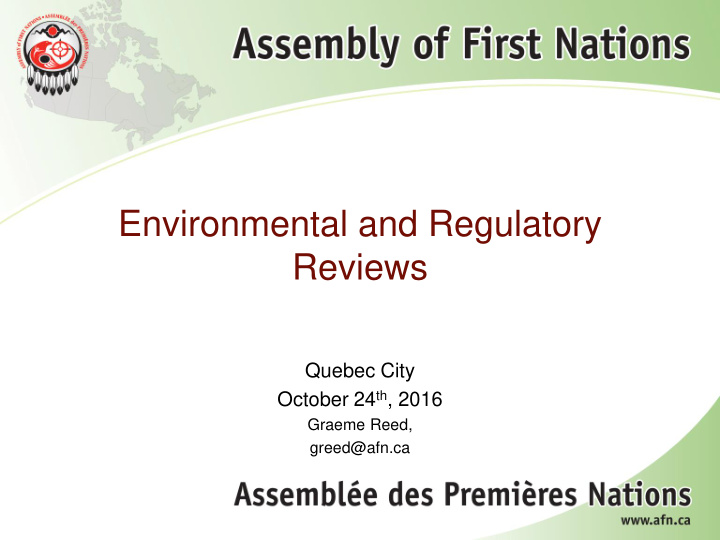



Environmental and Regulatory Reviews Quebec City October 24 th , 2016 Graeme Reed, greed@afn.ca
Objectives 1. Describe the EA review, the MIAC, and our potential to introduce a law system that supports First Nations 2. Provide some suggested themes and priorities to support these transition 3. Support each other in this journey together 2
Overview • Setting the context • Indigenous inclusion in the CEAA 2012 Review • What is the Multi-interest Advisory Committee? • Suggested themes and priorities for First Nations • Next steps 3
Setting the context On June 15 th , the federal government announced a review of the four environmental and regulatory processes: • CEAA 2012 is broken • Chance to re-engineer federal environmental assessment law in a manner that complies with Canada ’ s legal duties and responsibilities under domestic, constitutional, and international law. • Need to be open to the creation of an entirely new regulatory regime 4
Inclusion of Indigenous Peoples CEAA 2012 Review • “Ensuring Indigenous communities are full partners n the environmental assessment processes is a key element of renewing the relationship with Indigenous peoples…We are committed to renewing this relationship with Indigenous peoples based on the recognition of rights, respect, cooperation, and partnership ” – The Honourable Carolyn Bennett • “To recognize the objectives of the United Nations Declaration on the Rights of Indigenous Peoples, the Panel shall reflect the principles of the Declaration in its recommendations , as appropriate, especially in respect to the manner in which environmental assessment processes can be used to address potential impacts to potential or established Aboriginal and Treaty Rights .” – Terms of Reference, CEAA 2012 Review. 5
What is the Multi-interest Advisory Committee? • Indigenous Representatives (2 from each NIO), Industry Associations (6), and environmental non-governmental groups (6) • Provide advice on matters related to environmental assessment to the expert panel. – On the matters as requested by the expert panel, related to the Canadian Environmental Assessment Act, 2012 (CEAA 2012) to inform potential legislative, regulatory and policy changes – Provide advice on the potential role of the Committee after the review 6
Some potential themes and priorities for FN First Nations’ Rights as a guiding principle 1. First Nations’ jurisdictions 2. 1. Integrated, tiered assessments starting at the strategic and regional levels 2. Cumulative effects done regionally 3. Meaningful participation for Indigenous Peoples 4. Incorporation of Traditional Knowledge on a equal-footing to Western Science 7
Rights as a guiding principle • Recognize and respect the inherent and fundamental human rights of Indigenous peoples, affirmed in Section 35 of the Constitution of Canada, in all activities related to environmental assessment • Need to operationalize the United Nations Declaration on the Rights of Indigenous Peoples , including the right to Self-Determination and the Truth and Reconciliation Commission (TRC) • Recognize and uphold the Treaties • Stop over- delegating the Crown’s legal obligations (Duty to Consult) to proponents – contrary to the decisions in Haida Nation, 8
Indigenous Jurisdictions • First Nations occupy a place of priority in the EA dialogue because of inherent jurisdiction over traditional lands and territory and right to self- determination • Decision making needs to be based on a ‘Nation -to- Nation’ relationship • Coordination and collaboration between federal, provincial, and Indigenous regimes • A number of already possess self-governing EA regimes (Inuvialuit, Nisga’a, Nunatsiavut, Akwesasne, etc.) 9
Integrated, tiered assessments starting at the strategic and regional levels • Some questions need to be addressed at a level higher than project-level assessment. • Different types of evaluations are needed: – Regional environmental assessments: – Strategic environmental assessments: • Each level will inform the other 10
Cumulative effects done regionally • The most important environmental effects are often cumulative, so it is essential we take all projects into consideration. 11
Meaningful participation for Indigenous peoples • Standard of Free, Prior, and Informed Consent as a guide for participation / information. This includes: – Respect – Adequate public notice – Timely and convenient access to information – Adequate resources throughout the entire process – The capacity to influence the results. – Among many others… • Need a significant place throughout the entire review process: before strategic decisions are made, during the evaluation, and in the monitoring and follow-up. 12
Incorporation of Traditional Knowledge on a equal-footing to Western Science • ITK needs to be considered as “expert knowledge” outside of Western Science • Throughout the entire process – including before the project • Can help inform baseline studies, potential effects, cumulative effectives, interconnected ecosystem changes, etc… 13
Other areas of focus 1. Sustainability as a core objective Climate assessments to achieve Canada’s climate goals 2. 3. Credibility, transparency and accountability throughout 4. Ensuring sustainability after the assessment 5. Emphasis on learning 14
Next Steps – Get Involved! • Attend a presentation (www.eareview.ca) • Give specific examples of problems and solutions • Challenge the Panel to think BIG 15
Thank you / Merci Graeme Reed (greed@afn.ca) 16
Recommend
More recommend